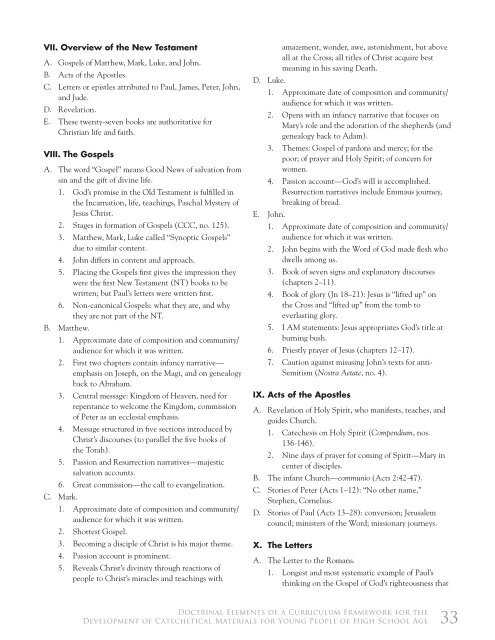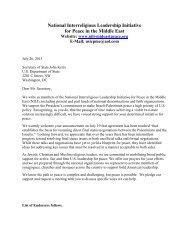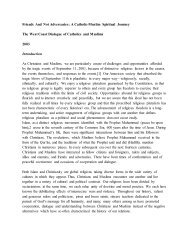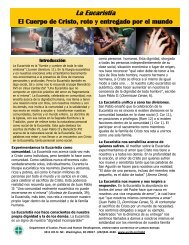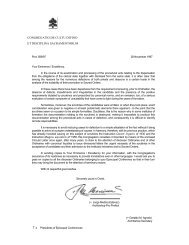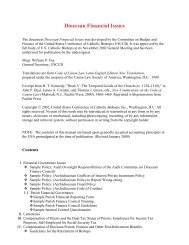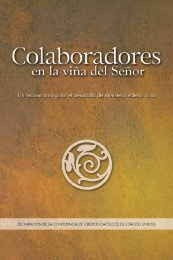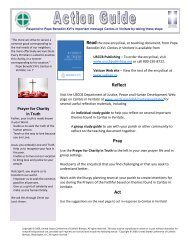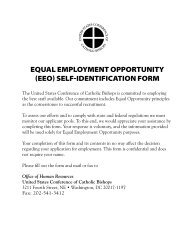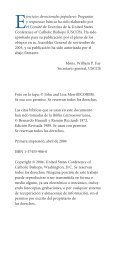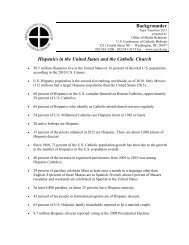Doctrinal Elements of a Curriculum Framework for the Development ...
Doctrinal Elements of a Curriculum Framework for the Development ...
Doctrinal Elements of a Curriculum Framework for the Development ...
- No tags were found...
You also want an ePaper? Increase the reach of your titles
YUMPU automatically turns print PDFs into web optimized ePapers that Google loves.
VII. Overview <strong>of</strong> <strong>the</strong> New TestamentA. Gospels <strong>of</strong> Mat<strong>the</strong>w, Mark, Luke, and John.B. Acts <strong>of</strong> <strong>the</strong> Apostles.C. Letters or epistles attributed to Paul, James, Peter, John,and Jude.D. Revelation.E. These twenty-seven books are authoritative <strong>for</strong>Christian life and faith.VIII. The GospelsA. The word “Gospel” means Good News <strong>of</strong> salvation fromsin and <strong>the</strong> gift <strong>of</strong> divine life.1. God’s promise in <strong>the</strong> Old Testament is fulfilled in<strong>the</strong> Incarnation, life, teachings, Paschal Mystery <strong>of</strong>Jesus Christ.2. Stages in <strong>for</strong>mation <strong>of</strong> Gospels (CCC, no. 125).3. Mat<strong>the</strong>w, Mark, Luke called “Synoptic Gospels”due to similar content.4. John differs in content and approach.5. Placing <strong>the</strong> Gospels first gives <strong>the</strong> impression <strong>the</strong>ywere <strong>the</strong> first New Testament (NT) books to bewritten; but Paul’s letters were written first.6. Non-canonical Gospels: what <strong>the</strong>y are, and why<strong>the</strong>y are not part <strong>of</strong> <strong>the</strong> NT.B. Mat<strong>the</strong>w.1. Approximate date <strong>of</strong> composition and community/audience <strong>for</strong> which it was written.2. First two chapters contain infancy narrative—emphasis on Joseph, on <strong>the</strong> Magi, and on genealogyback to Abraham.3. Central message: Kingdom <strong>of</strong> Heaven, need <strong>for</strong>repentance to welcome <strong>the</strong> Kingdom, commission<strong>of</strong> Peter as an ecclesial emphasis.4. Message structured in five sections introduced byChrist’s discourses (to parallel <strong>the</strong> five books <strong>of</strong><strong>the</strong> Torah).5. Passion and Resurrection narratives—majesticsalvation accounts.6. Great commission—<strong>the</strong> call to evangelization.C. Mark.1. Approximate date <strong>of</strong> composition and community/audience <strong>for</strong> which it was written.2. Shortest Gospel.3. Becoming a disciple <strong>of</strong> Christ is his major <strong>the</strong>me.4. Passion account is prominent.5. Reveals Christ’s divinity through reactions <strong>of</strong>people to Christ’s miracles and teachings withamazement, wonder, awe, astonishment, but aboveall at <strong>the</strong> Cross; all titles <strong>of</strong> Christ acquire bestmeaning in his saving Death.D. Luke.1. Approximate date <strong>of</strong> composition and community/audience <strong>for</strong> which it was written.2. Opens with an infancy narrative that focuses onMary’s role and <strong>the</strong> adoration <strong>of</strong> <strong>the</strong> shepherds (andgenealogy back to Adam).3. Themes: Gospel <strong>of</strong> pardons and mercy; <strong>for</strong> <strong>the</strong>poor; <strong>of</strong> prayer and Holy Spirit; <strong>of</strong> concern <strong>for</strong>women.4. Passion account—God’s will is accomplished.Resurrection narratives include Emmaus journey,breaking <strong>of</strong> bread.E. John.1. Approximate date <strong>of</strong> composition and community/audience <strong>for</strong> which it was written.2. John begins with <strong>the</strong> Word <strong>of</strong> God made flesh whodwells among us.3. Book <strong>of</strong> seven signs and explanatory discourses(chapters 2–11).4. Book <strong>of</strong> glory (Jn 18–21): Jesus is “lifted up” on<strong>the</strong> Cross and “lifted up” from <strong>the</strong> tomb toeverlasting glory.5. I AM statements: Jesus appropriates God’s title atburning bush.6. Priestly prayer <strong>of</strong> Jesus (chapters 12–17).7. Caution against misusing John’s texts <strong>for</strong> anti-Semitism (Nostra Aetate, no. 4).IX. Acts <strong>of</strong> <strong>the</strong> ApostlesA. Revelation <strong>of</strong> Holy Spirit, who manifests, teaches, andguides Church.1. Catechesis on Holy Spirit (Compendium, nos.136-146).2. Nine days <strong>of</strong> prayer <strong>for</strong> coming <strong>of</strong> Spirit—Mary incenter <strong>of</strong> disciples.B. The infant Church—communio (Acts 2:42-47).C. Stories <strong>of</strong> Peter (Acts 1–12): “No o<strong>the</strong>r name,”Stephen, Cornelius.D. Stories <strong>of</strong> Paul (Acts 13–28): conversion; Jerusalemcouncil; ministers <strong>of</strong> <strong>the</strong> Word; missionary journeys.X. The LettersA. The Letter to <strong>the</strong> Romans.1. Longest and most systematic example <strong>of</strong> Paul’sthinking on <strong>the</strong> Gospel <strong>of</strong> God’s righteousness that<strong>Doctrinal</strong> <strong>Elements</strong> <strong>of</strong> a <strong>Curriculum</strong> <strong>Framework</strong> <strong>for</strong> <strong>the</strong><strong>Development</strong> <strong>of</strong> Catechetical Materials <strong>for</strong> Young People <strong>of</strong> High School Age33


